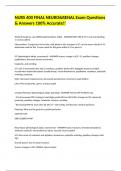NURS 400 FINAL NEURO&RENAL Exam Questions
& Answers 100% Accurate!!
Stroke/Emergency care (ROR/Implementation, SATA) - ANSWER-ROR: MRI & CT to rule out bleeding,
1:1 nurse patient
Interventions: 2 large-bore IVs for labs, walk blood to lab, transport to CT, q4 min neuro checks & VS,
determine need for tPA, 2 nurse check for tPA given within 4 1⁄2 hrs post s/s
ICP (physiological adapt, assessment) - ANSWER-Assess: change in LOC, VS, pupillary changes,
papilledema, decrease sensory and motor,
headache, and vomiting
S/S: LOC is decreased early, late is comatose, pupillary dysfunction (sluggish response to light),
occulomotor dysfunction/ptosis (eyelid droop), visual disturbances, papilledma, weakness, projectile
vomiting, posturing
Early: decreased responsivness, decreased spontaneous movement, pupil dilation
Late: HTN, bradycardia, apnea, unequal pupils
Cerebral Perfusion (physiological adapt, planning) - ANSWER-Normal CPP 60-80mm Hg
- S/S of increased CPP: Cushing's triad (high systolic BP, low HR & RR), changes in LOC, abnormal
posturing, pupillary changes, headache, seizures, vomiting
- Decreasing MAP by more than 20-25% or <110 mmHg, will decrease cerebral perfusion
Planning: What are the goals for cerebral perfusion
MAP-ICP=CPP
(SBP-(2)DBP)3=MAP
Head Injury (physiological adapt, assessment) - ANSWER-Types: fractures, hematomas(epidural,
subdural, cerebral), neuronal(nerve) injury, vascular, focal vs global
S/S: New onset of confusion and agitation, drowsiness, projectile vomiting, pupillary changes, Halo
sign
slurred speech, loss of motor function
Assess: changes in LOC, PEERLA, Neuro checks




